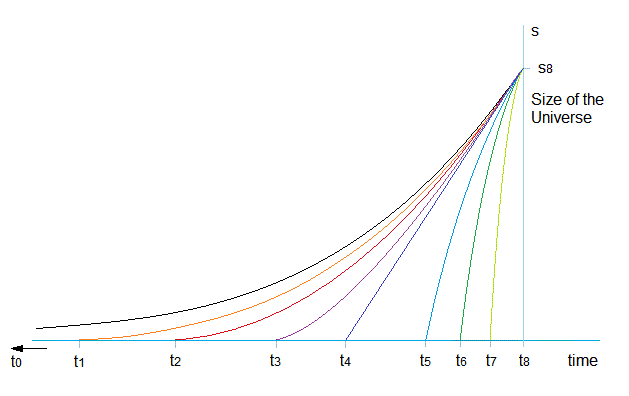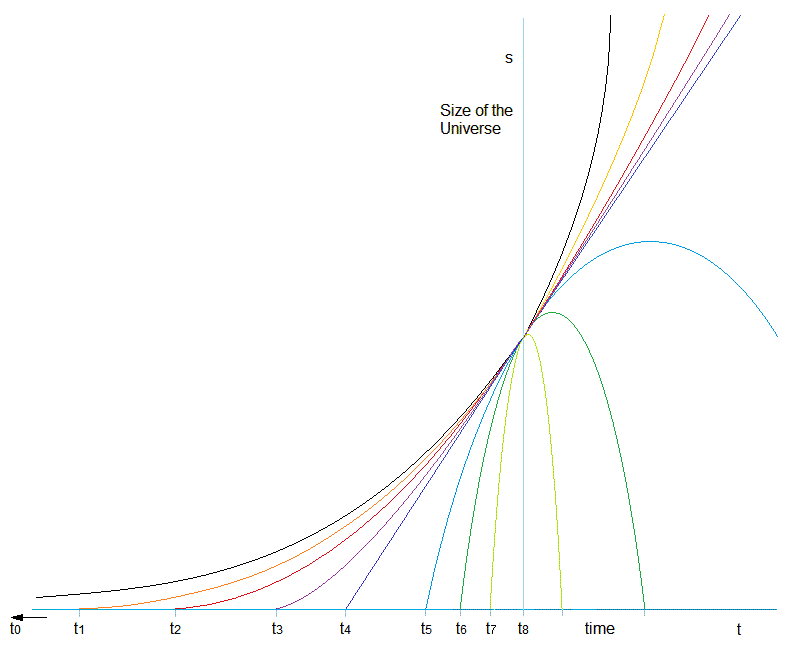The accelerating expansion of the Universe
Hubble's Law
Distant galaxies appear to be receding from us because the universe is expanding. The velocity of recession is given by Hubble's Law, v = H0.d, where d is the 'proper distance' and H0 is the Hubble Constant whose value is estimated at about 70 Km/s per Megaparsec. The Hubble Constant implies that the rate of expansion is constant (no acceleration). If the expansion is accelerating then the term H0 is not constant over time, and the age of the universe is different from the value obtained using the Hubble Constant.The Hubble Constant
H0 = (70 Km/s)/Mpc
1 Mpc = 3.086 x 1019 Km
H0 = 70/(3.086 x 1019) s-1
H0 = 2.2658 x 10-18 s-1
The age of the Universe according to Hubble's Law
t = 1/H0
t = 1/(2.2658 x 10-18) seconds
t = 4.408 x 1017 seconds
t = 13.97 x 109 years
With the equipment available at the time, Hubble was only able to estimate the speed of recession for relatively nearby galaxies. In the graph below, the curves almost merge as a straight line in this region so a constant rate of recession was a valid assumption.
Histories of the Universe
At the present time, t8, all the curves have the same slope (rate of expansion) as given by Hubble's Law. Use this as the starting point and work backwards to estimate the age of the Universe for each scenario. |
llustrated in the above graph by one scenario.
Acceleration is zero. This is the history of the Universe predicted by Hubble's Law.
Work backwards from the present time to estimate the age of the Universe.
No acceleration - the Universe began at t4
The Universe began with a Big Bang. The initial rate of expansion was finite. The Universe expanded at a constant rate. The curve is a straight line.
s = K4.(t - t4)
Accelerating expansion
The current view is that the expansion of the Universe is accelerating.
llustrated in the above graph by four scenarios.
Acceleration is positive. All the curves have the same slope (rate of expansion) at the present time, t8.
Constant acceleration - the Universe began at t2
This is the history of the Universe if it expanded with constant acceleration. The Universe began with a Soft Start. The initial rate of expansion was zero. The curve is part of a parabola. s = K2.(t - t2)2
Only one parabola will fit, so from the graph it appears that if the Universe has accelerated at a constant rate then it is twice as old as the Hubble estimate. (I prove this mathematically later in this article).
Decreasing acceleration - the Universe began between t2 and t4
The curve showing the Universe beginning at t3 is an example. This is the history of the Universe if it expanded with decreasing acceleration. The Universe began with a Big Bang or a Soft Start at its maximum acceleration. The closer t3 was to t2 the softer the start. The Universe has always accelerated but the rate of acceleration has decreased with time.
Increasing acceleration, the limiting case - the Universe is infinitely old - t0 is infinite time before present
The Universe gradually started to expand with ever increasing acceleration until reaching its present rate of expansion. The Universe has always existed. The Universe began with a Soft Start. The initial rate of expansion was zero. The Universe has always accelerated but the rate of acceleration has increased with time. Eventually the Universe will expand with almost infinite acceleration. s = K0.(t - t0)∞
Increasing acceleration - the Universe began between t0 and t2
The curve showing the Universe beginning at t1 is an example. This is the history of the Universe if it began at a finite time before the present then expanded with increasing acceleration. The Universe began with a Soft Start. The initial rate of expansion was zero. The Universe has always accelerated but the rate of acceleration has increased with time. Eventually the Universe will expand with almost infinite acceleration.
Decelerating expansion
Illustrated in the above graph in three scenarios.
Acceleration is negative.
All the curves have the same slope (rate of expansion) at the present time, t8
Constant deceleration - the Universe began at t6
This is the history of the Universe if it expanded with constant deceleration. The Universe began with a Big Bang. The initial rate of expansion was finite. Eventually the expansion will reverse. The curve is part of a parabola.
Decreasing deceleration - the Universe began between t4 and t6
The curve showing the Universe beginning at t5 is an example. This is the history of the Universe if it expanded with decreasing deceleration. The Universe began with a Big Bang at its maximum deceleration. The rate of deceleration has decreased with time. Eventually the expansion will reverse.
Increasing deceleration - the Universe began between t6 and t8
The curve showing the Universe beginning at t7 is an example. This is the history of the Universe if it expanded with increasing deceleration. The Universe began with a Big Bang at its minimum deceleration. The rate of deceleration has increased with time. Eventually the expansion will reverse.
Futures of the Universe
At the present time, t8, all the curves have the same slope (rate of expansion).Work forwards to estimate the future of the Universe for each scenario.
 |
No acceleration - the Universe which began at t4
This is the future of the Universe defined by the Hubble Constant. The Universe will expand at a constant rate for an infinite time and to an infinite extent. The curve is a straight line. s = K4.(t - t4)
Accelerating expansion
Constant acceleration - the Universe which began at t2
This is the future of the Universe expanding with constant acceleration. The Universe will expand with constant acceleration for an infinite time and to an infinite extent. The curve is part of a parabola. s = K2.(t - t2)2
Decreasing acceleration - the Universe which began between t2 and t4
The curve showing the Universe beginning at t3 is an example. This is the future of the Universe if it expanded with decreasing acceleration. The Universe will expand with decreasing acceleration for an infinite time and to an infinite extent. Eventually the Universe will expand at an almost constant rate.
Increasing acceleration, the limiting case - the Universe which began at t0
The Universe carries on expanding at an ever increasing rate of acceleration. The Universe will expand with increasing acceleration for an infinite time and to an infinite extent. Eventually the Universe will expand with almost infinite acceleration.
Increasing acceleration - the Universe which began between t0 and t2
The curve showing the Universe beginning at t1 is an example. This is the future of the Universe if it began at a finite time before the present then expanded with increasing acceleration. The Universe will expand with increasing acceleration for an infinite time and to an infinite extent. Eventually the Universe will expand with almost infinite acceleration.
Decelerating expansion
Constant deceleration - the Universe which began at t6
This is the future of the Universe expanding with constant deceleration. The curve is part of a parabola. The expansion will reverse. Eventually the Universe will end with a Big Crunch.
Decreasing deceleration - the Universe which began between t4 and t6
The curve showing the Universe beginning at t5 is an example. This is the future of the Universe expanding with decreasing deceleration. The expansion will reverse. The Universe will end with a Big Crunch or a Soft Landing.
Increasing deceleration - the Universe which began between t6 and t8
The curve showing the Universe beginning at t7 is an example. This is the future of the Universe expanding with increasing deceleration. The expansion will reverse. Eventually the Universe will contract at an accelerating rate and will end with a Big Crunch at maximum acceleration.
Some other thoughts
An interesting point is that the curve starting at t4 increases indefinitely, whereas a curve starting in the region between t4 and t6, starting only an instant after t4, will eventually reverse.
Also, there seems to be a contradiction in the results. Curves starting before t4, such as t3, start at a slower rate than the Hubble rate but continue indefinitely. Curves starting after t4, such as t5, start at a faster rate than the Hubble rate but eventually reverse. The faster they start, the sooner they reverse. There is actually no contradiction. The curves are constrained to have the same slope at t8. The curves, such as t3, start at a slower rate and accelerate while curves, such as t5, start at a faster rate but decelerate.
To
show that the Universe beginning
at t2
is
twice the age of the Universe beginning
at t4
The
parabola s =
K2
(t
-
t2)2
and
the straight line s = K4.(t
-
t4)
meet
at t8,s8.
s8
=
K4.(t8
-
t4)
s8
=
K2.(t8
-
t2)2
So,
K4.(t8
-
t4) = K2.(t8
-
t2)2
K4/K2
= (t8
- t2)2/(t8
- t4)
. . . . . . 1
The parabola s = K2 (t - t2)2 and the straight line s = K4.(t - t4) have the same slope at t8,s8.
s
= K4.(t
-
t4)
The slope, ds/dt = K4
The
slope at t8
is
also K4
s
= K2.(t
- t2)2
The
slope, ds/dt = 2K2.(t
- t2)
The slope at t8
=
2K2.(t8
-
t2)
So,
K4
=
2K2.(t8
-
t2)
K4/K2
=
2(t8
- t2)
. . . . . . . 2
From
equations 1 and 2.
(t8
-
t2)2/(t8
-
t4)
= 2(t8
-
t2)
(t8
- t2)
= 2(t8
- t4)
Interestingly, this means that t2 is always twice as far in the past as t4 whatever the values of K2 and K4.
Why only one parabola fits
The parabola is given by s = K2.(t - t2)2
K4 = 2K2.(t8 - t2) and (t8 - t2) = 2(t8 - t4)
So, K2 = K4/4(t8 - t4)
s = K2.(t - t2)2
s = K4.4(t - t2)2/4(t8 - t4)
s = K4.(t - t2)2/(t8 - t4)
So, once you have established the constants K4 and (t8 - t4) from Hubble's Law, the only parabola that will fit is s = K4.(t - t2)2/(t8 - t4).
In other words s = K2.(t - t2)2..
Conclusion
This article suggests that if the age of the Universe is the Hubble estimate (currently 13.97 x 109 years) or greater, the expansion will continue for ever. If the age is less than the Hubble estimate, the expansion will eventually reverse and the Universe will contract to a Big Crunch or Soft Landing.This means that if the expansion of the Universe is accelerating, then the age of the universe must be greater than the Hubble estimate.
In my Negative Mass article I concluded that, "The acceleration was at a maximum at the Big Bang and is decreasing with time. Eventually, the velocity of expansion will be almost but never quite constant." This puts the beginning of the Universe in the region between t2 and t4. The age of the Universe in this scenario is greater than the Hubble estimate.
Mike Holden - Nov 2014